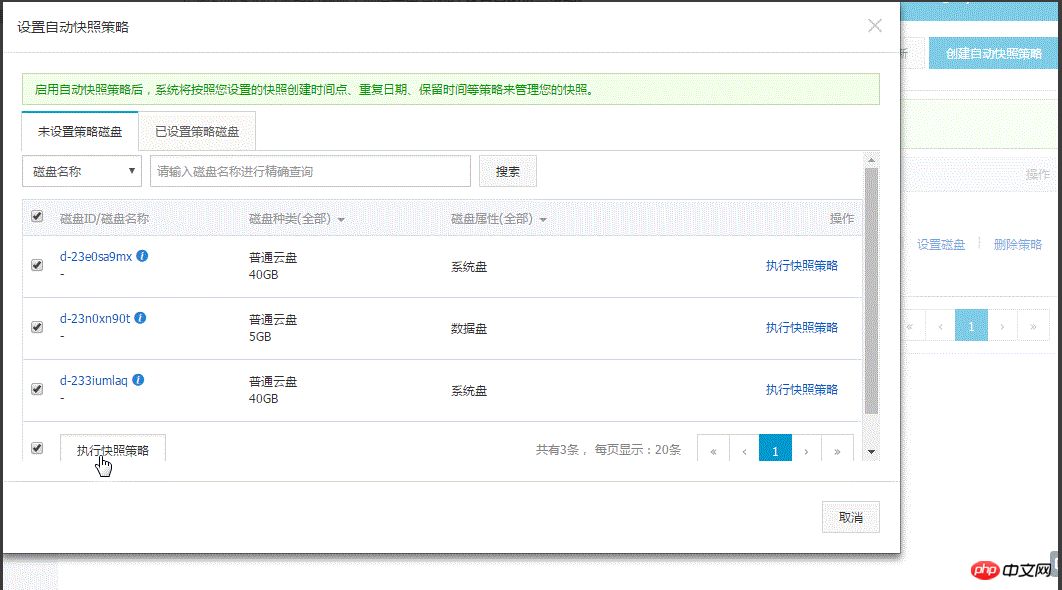 Operation and Maintenance
Operation and Maintenance
 Linux Operation and Maintenance
Linux Operation and Maintenance
 How to specify the automatic snapshot policy to be executed through disk entry or snapshot entry
How to specify the automatic snapshot policy to be executed through disk entry or snapshot entry
How to specify the automatic snapshot policy to be executed through disk entry or snapshot entry
The content of this article is about how to specify the automatic snapshot strategy for execution through disk entry or snapshot entry. It has certain reference value. Friends in need can refer to it. I hope it will be helpful to you.
Set automatic snapshot policy for disk
You can set automatic snapshot policy for disk according to business needs.
The naming format of automatic snapshots is: auto_yyyyMMdd_1, such as auto_20140418_1
Description
When you create a snapshot, it will cause certain fluctuations in your disk read and write. It is strongly recommended to follow your Business load, choose to perform automatic snapshots during periods of low business load to reduce the impact on your business.
Ordinary cloud disks that are not in use will not implement the automatic snapshot policy.
There is no conflict between the snapshot you create manually and the automatic snapshot. However, when an automatic snapshot is being performed on a certain disk, you need to wait for the automatic snapshot to complete before manually creating a snapshot.
You can specify the automatic snapshot policy to be executed through the disk entry or snapshot entry.
Disk entry: Only execute the automatic snapshot policy for a certain disk, please operate from the disk entry.
Snapshot entry: To uniformly execute automatic snapshot policies on multiple disks or all disks, please operate from the automatic snapshot entry.
Disk Entry
This method is suitable for specifying an automatic snapshot policy for a disk.
The operation is as follows:
Log in to the cloud server management console.
Select a region.
Click Cloud Disk in the left navigation.
Find the disk that needs to execute the policy, and then click on the right to set the automatic snapshot policy.
You can start the automatic snapshot function and select the snapshot strategy you want to use.
Click OK.
Snapshot entry
This method is suitable for specifying automatic snapshot policies for multiple disks at the same time.
Log in to the cloud server management console.
Select a region. You can see a list of all automatic snapshot policies in the region.
Click Snapshot > Automatic Snapshot Policy in the left navigation.
Find the automatic snapshot policy that needs to be executed, and click Set Disk on the right side of it.
Click the Disk without Policy Setup tab, find the disk on which you want to execute the policy, and click Execute Snapshot Policy on the right side of it; or select multiple disks, and click Execute Snapshot Policy below.

If you want to cancel the snapshot policy, click the Set Policy Disk tab, find the disk on which you want to execute the policy, and click Cancel Snapshot Policy on the right; or select For multiple disks, click Cancel Snapshot Policy below.

The above is the detailed content of How to specify the automatic snapshot policy to be executed through disk entry or snapshot entry. For more information, please follow other related articles on the PHP Chinese website!

Hot AI Tools

Undresser.AI Undress
AI-powered app for creating realistic nude photos

AI Clothes Remover
Online AI tool for removing clothes from photos.

Undress AI Tool
Undress images for free

Clothoff.io
AI clothes remover

Video Face Swap
Swap faces in any video effortlessly with our completely free AI face swap tool!

Hot Article

Hot Tools

Notepad++7.3.1
Easy-to-use and free code editor

SublimeText3 Chinese version
Chinese version, very easy to use

Zend Studio 13.0.1
Powerful PHP integrated development environment

Dreamweaver CS6
Visual web development tools

SublimeText3 Mac version
God-level code editing software (SublimeText3)

Hot Topics
 What computer configuration is required for vscode
Apr 15, 2025 pm 09:48 PM
What computer configuration is required for vscode
Apr 15, 2025 pm 09:48 PM
VS Code system requirements: Operating system: Windows 10 and above, macOS 10.12 and above, Linux distribution processor: minimum 1.6 GHz, recommended 2.0 GHz and above memory: minimum 512 MB, recommended 4 GB and above storage space: minimum 250 MB, recommended 1 GB and above other requirements: stable network connection, Xorg/Wayland (Linux)
 vscode cannot install extension
Apr 15, 2025 pm 07:18 PM
vscode cannot install extension
Apr 15, 2025 pm 07:18 PM
The reasons for the installation of VS Code extensions may be: network instability, insufficient permissions, system compatibility issues, VS Code version is too old, antivirus software or firewall interference. By checking network connections, permissions, log files, updating VS Code, disabling security software, and restarting VS Code or computers, you can gradually troubleshoot and resolve issues.
 How to run java code in notepad
Apr 16, 2025 pm 07:39 PM
How to run java code in notepad
Apr 16, 2025 pm 07:39 PM
Although Notepad cannot run Java code directly, it can be achieved by using other tools: using the command line compiler (javac) to generate a bytecode file (filename.class). Use the Java interpreter (java) to interpret bytecode, execute the code, and output the result.
 Can vscode be used for mac
Apr 15, 2025 pm 07:36 PM
Can vscode be used for mac
Apr 15, 2025 pm 07:36 PM
VS Code is available on Mac. It has powerful extensions, Git integration, terminal and debugger, and also offers a wealth of setup options. However, for particularly large projects or highly professional development, VS Code may have performance or functional limitations.
 What is vscode What is vscode for?
Apr 15, 2025 pm 06:45 PM
What is vscode What is vscode for?
Apr 15, 2025 pm 06:45 PM
VS Code is the full name Visual Studio Code, which is a free and open source cross-platform code editor and development environment developed by Microsoft. It supports a wide range of programming languages and provides syntax highlighting, code automatic completion, code snippets and smart prompts to improve development efficiency. Through a rich extension ecosystem, users can add extensions to specific needs and languages, such as debuggers, code formatting tools, and Git integrations. VS Code also includes an intuitive debugger that helps quickly find and resolve bugs in your code.
 How to check the warehouse address of git
Apr 17, 2025 pm 01:54 PM
How to check the warehouse address of git
Apr 17, 2025 pm 01:54 PM
To view the Git repository address, perform the following steps: 1. Open the command line and navigate to the repository directory; 2. Run the "git remote -v" command; 3. View the repository name in the output and its corresponding address.
 Linux Architecture: Unveiling the 5 Basic Components
Apr 20, 2025 am 12:04 AM
Linux Architecture: Unveiling the 5 Basic Components
Apr 20, 2025 am 12:04 AM
The five basic components of the Linux system are: 1. Kernel, 2. System library, 3. System utilities, 4. Graphical user interface, 5. Applications. The kernel manages hardware resources, the system library provides precompiled functions, system utilities are used for system management, the GUI provides visual interaction, and applications use these components to implement functions.
 How to use VSCode
Apr 15, 2025 pm 11:21 PM
How to use VSCode
Apr 15, 2025 pm 11:21 PM
Visual Studio Code (VSCode) is a cross-platform, open source and free code editor developed by Microsoft. It is known for its lightweight, scalability and support for a wide range of programming languages. To install VSCode, please visit the official website to download and run the installer. When using VSCode, you can create new projects, edit code, debug code, navigate projects, expand VSCode, and manage settings. VSCode is available for Windows, macOS, and Linux, supports multiple programming languages and provides various extensions through Marketplace. Its advantages include lightweight, scalability, extensive language support, rich features and version





